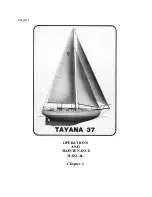
Section 11
11-8
Galvanic Corrosion
Galvanic corrosion (electrolysis) is the deterioration of metals from the effects of
electrolytic action. When two dissimilar metals are immersed in a conductive fluid
such as salt water, an electric current is produced, much like a battery. As current
flows between the two metals, the softer, or sacrificial, metal deteriorates.
If you operate in salt, polluted or brackish waters, your boat should be equipped
with a transom-mounted sacrificial anode to prevent corrosion damage to other
metal parts of your boat that are in contact with the water. The anodes are
self-sacrificing and are slowly eroded by electrolytic action. These anodes are
important and require periodic inspection for deterioration. Replace the anode
when less than 50% of its original size.
Most engines are equipped with one or more anodes that require periodic
inspection. See the
Engine Operator’s Manual
for maintenance procedures.
Electronic cathode systems are designed to reduce the effects of electrolysis.
Electronic cathode systems emit an electrical low-current charge into the water
near the metal components’ neutralizing electrolytic action.
NOTICE: Do not paint
or coat sacrificial anodes or cathodes with any substance. Once covered, they do
not provide protection from galvanic corrosion. Replace anodes if they have
deteriorated 50% or more.
Salt Water Corrosion
Rinse your boat hull and deck with fresh water and wash immediately after using
your boat in salt water. If your boat is used primarily in salt water, wax the hull
monthly and apply corrosion inhibitor to all hardware. See the
Engine Operator’s
Manual
for the flushing procedure.
Flushing the freshwater engine cooling system is recommended when the engine
has been used in salt, polluted or brackish waters. Flush the entire engine cooling
system with fresh water for at least 5 minutes after use in these waters. Consult
your local marine dealer for suitable flushing equipment.
GENERAL MAINTENANCE AND
CLEANING
Marine Growth
If accelerated marine growth is a problem in your area, an antifouling bottom paint
may be necessary to slow growth and prevent gelcoat damage. Before selecting a
bottom paint, talk with other boaters and your local marine dealer to determine
which product works best in your area. Many local variables can affect the
selection of paint. Be sure to follow the paint manufacturer’s directions exactly.
Copyright
2019
Ken
Cook
Co.
All
Rights
Reserved
www.KenCook.com/marine
Summary of Contents for Fi21
Page 1: ...Centurion_Cover_2019_Layout 1 10 24 2018 9 48 AM Page 1...
Page 3: ...This Page Intentionally Left Blank...
Page 7: ...iv This Page Intentionally Left Blank...
Page 17: ...Section 1 1 10 This Page Intentionally Left Blank...
Page 27: ...Section 2 2 10 This Page Intentionally Left Blank...
Page 48: ...Safety 3 21 Figure 3 4 Figure 3 4 CNTRN 0050B A...
Page 68: ...Safety 3 41 Figure 3 10Centurion Ri237 Figure 3 13 Figure 3 11Centurion Ri217 Figure 3 14...
Page 69: ...Section 3 3 42 Figure 3 12Centurion Fi25 Figure 3 15 Figure 3 13Centurion Fi23 Figure 3 16...
Page 70: ...Safety 3 43 Figure 3 14Centurion Fi21 Figure 3 17...
Page 71: ...Section 3 3 44 This Page Intentionally Left Blank...
Page 131: ...Section 8 8 24 Fi23 Ballast Tank Locations Figure 8 22 Fi21 Ballast Tank Locations Figure 8 23...
Page 165: ...Section 10 10 10 This Page Intentionally Left Blank...
















































